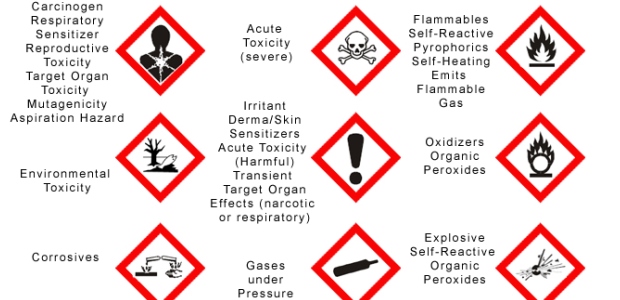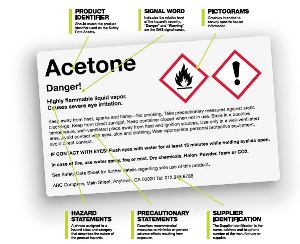
Hazard Communication Program — Training is the Key
Employees are to be trained when they are initially assigned to work with a hazardous chemical. Additional training is to be done whenever a new health or physical hazard is introduced into the work area.
- By Sally J. Smart
- Jan 01, 2017
The intent and purpose of the Occupational Safety and Health Administration's Hazard Communication Standard (29 Code of Federal Regulations 1910.1200) is "to ensure that the hazards of all chemicals produced or imported are classified, and that information concerning the classified hazards is transmitted to employers and employees" (29 CFR 1910.1200(a)(1).
Employers must ensure that employees who may be exposed to hazardous chemicals under normal operating conditions or in foreseeable emergencies are adequately trained and are equipped with the knowledge and information necessary to do their jobs safely.
Hazard Communication Standard Revised
In May 2012, OSHA revised the Hazard Communication Standard (HCS 2012) and adopted portions of the United Nations' Globally Harmonized System of Classification and Labeling of Chemicals (GHS) Revision 3. This set in motion a series of compliance deadlines for chemical manufacturers, importers, distributors, and employers who are covered by the standard:
- Dec. 1, 2013: Train employees on the new label elements and safety data sheet (SDS) format.
- June 1, 2015: Comply with all modified provisions of the final rule, except:
□ Dec. 1, 2015: Distributors must not ship containers of hazardous materials labeled by the chemical manufacturer or importer unless they carry the appropriate HCS label.
□ June 1, 2016: Update alternative workplace labeling and hazard communication program as necessary and provide additional employee training for newly identified physical or health hazards.
HCS 2012 still requires chemical manufacturers and importers to evaluate the chemicals they produce or import and provide hazard information to employers and workers by putting labels on containers and preparing Safety Data Sheets. HCS 2012 provides a single set of harmonized criteria for classifying chemicals according to their health and physical hazards. These hazards are then communicated to downstream users through the use of "shipped container labels" and standardized SDSs. The "old" standard (HCS 1994) allowed chemical manufacturers and importers to convey hazard information on labels and material safety data sheets (MSDSs) in whatever format they chose.
Training Basics
Employers must ensure that their employees are adequately trained and are equipped with the knowledge and information necessary to do their jobs safely. Training can be accomplished in many ways (audiovisuals, classroom instruction, interactive video) and should include an opportunity for employees to ask questions to make certain that they understand the information presented to them.
Under HCS 2012, OSHA requires that employee training include at least the:
- Methods and observations that may be used to detect the presence or release of a hazardous chemical in the work area;
- Measures employees can take to protect themselves from these hazards; and
- Details of the hazard communication program developed by the employer, including an explanation of the labels received on shipped containers and the workplace labeling system used by their employer; the SDS, and how employees can obtain and use the appropriate hazard information.
Employees are to be trained when they are initially assigned to work with a hazardous chemical. Additional training is to be done whenever a new health or physical hazard is introduced into the work area.
If employers customarily need to communicate work instructions or other workplace information to employees in a language other than English, they will also need to provide hazard communication training in the same manner.
Shipped Container Labels
Training on the shipped container labels must include information on:
The required six standardized elements:
□ Product identifier—how the hazardous chemical is identified;
□ Signal word—used to indicate the relative level of hazard severity;
□ Pictogram(s)—used to convey the health, physical and environmental hazards;
□ Hazard statement(s)—describes the nature and degree of the hazard(s);
□ Precautionary statement(s)—phrase(s) that describe recommended measures that should be taken to minimize or prevent adverse effects resulting from exposure to the hazardous chemical or improper storage or handling; and
□ Name, address, and phone number of the chemical manufacturer, distributor, or importer.
How an employee might use the labels in the workplace:
□ Explain how information on the label can be used to ensure proper storage of hazardous chemicals.
□ Explain how the information on the label might be used to quickly locate information on first aid when needed by employees or emergency personnel.
General understanding of how the elements work together on the label:
□ Explain that when a chemical has multiple hazards, different pictograms are used to identify the various hazards.
□ Explain that when there are similar precautionary statements, the one providing the most protective information is included on the label.

Workplace Labels
HCS 2012 continues to give employers the flexibility to determine what types of workplace labels they will use. Employers may choose to label workplace containers either with the same label that would be on shipped containers for the chemical or with alternative labels. Alternative labeling systems such as the National Fire Protection Association (NFPA) 704 Hazard Rating and the Hazardous Material Identification System (HMIS) are permitted for workplace containers. Because these alternative labels provide only the product identifier and general information regarding the hazards of the chemicals, employers must also make specific information regarding the physical and health hazards of the chemical immediately available to employees.
Safety Data Sheets
Training on the format of the SDS must include information on:
- The standardized 16-section format, including the type of information found in the various sections.
- How the information on the label is related to the SDS.
When OSHA revised the HCS, it selected June 1, 2015, as the deadline by which chemical manufacturers, importers, and distributors were to complete the process of reclassifying hazardous chemicals and to have updated all SDSs and shipped container labels to the new formats. A significant number did not make the June 1 deadline. Because of this, employers may have a library of HCS 1994, American National Standards Institute Hazardous Workplace Chemicals - Hazard Evaluation and Safety Data Sheet and Precautionary Labeling Preparation standard ANSI Z400.1 / Z129.1-2010, and HCS 2012 compliant SDSs. The following table provides a comparison of the SDS elements for HCS 1994, ANSI Z400.1 and HCS 2012 for training purposes.
Conclusion
As a user of hazardous chemicals, you must update SDSs when new ones become available, provide training on newly identified hazards, and update your hazard communication programs when new hazards are identified.
Editor's note: The lengthy chart comparing SDS elements for HCS 1994, ANSI Z400.1, and HCS 2012 is included on pages 35-36 of the January 2017 print issue of Occupational Health & Safety but could not be posted in this online version of the article.
This article originally appeared in the January 2017 issue of Occupational Health & Safety.